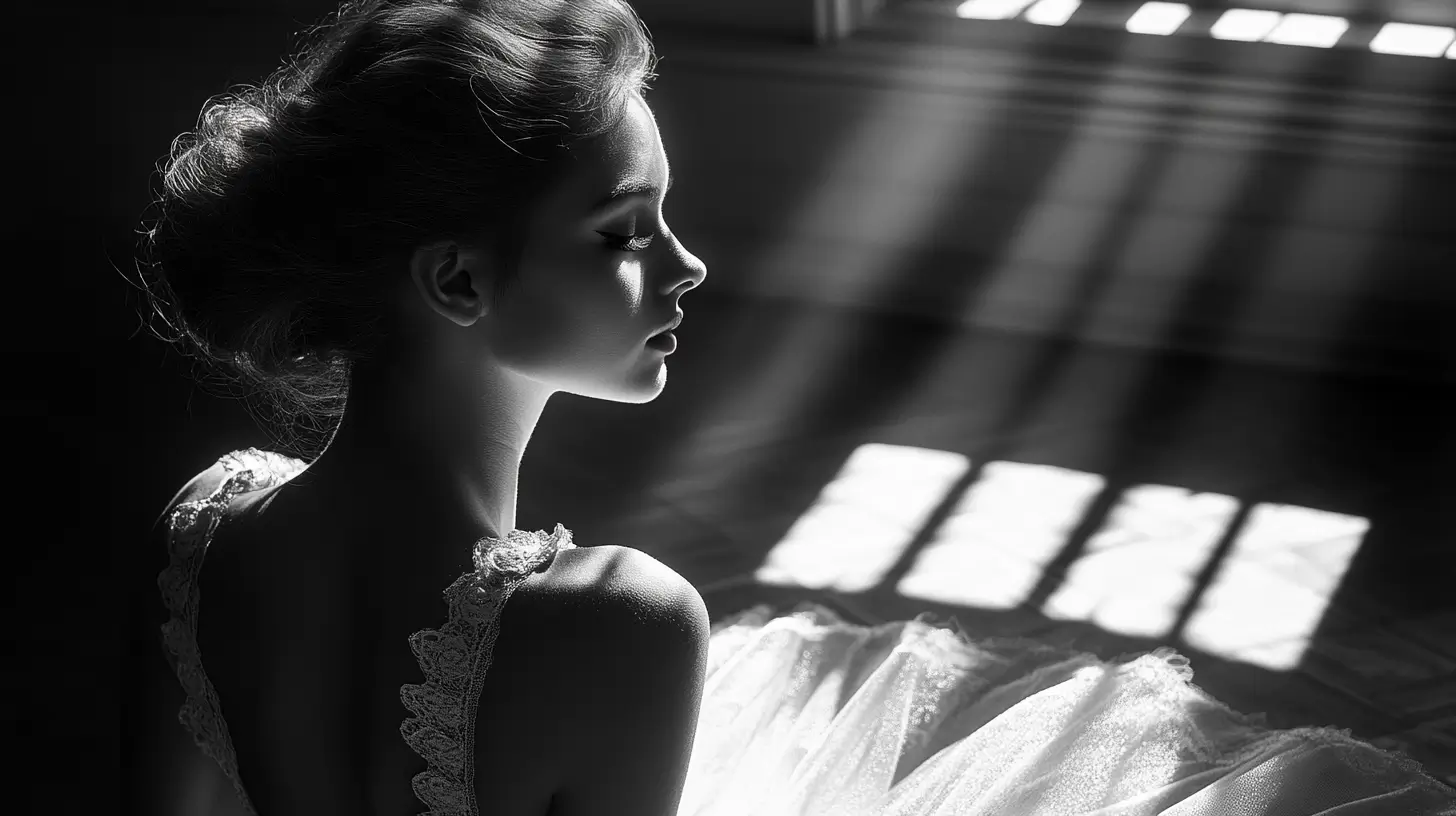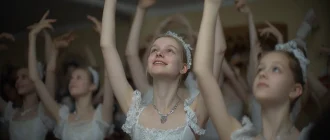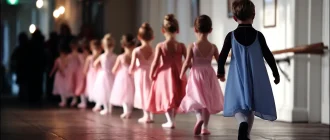What are the key ballerina requirements? This article breaks down the crucial physical attributes, the importance of ballet classes in early training and skill development, technical skills, and the career preparation needed to succeed in ballet.
Key Takeaways
- Aspiring ballet dancers must develop essential physical attributes such as flexibility, strength, and coordination to excel in their craft.
- Early training, preferably between ages 5 and 8, combined with attendance at professional ballet schools, is crucial for building foundational skills and enhancing career prospects.
- Emotional and mental resilience, alongside strong performance skills like musicality and stage presence, are vital for dancers to connect with their audience and navigate the competitive ballet industry.
Art de Podcast
| Requirement | Description | Tips for Aspiring Dancers |
|---|---|---|
| Physical Fitness & Stamina | High strength, flexibility, and endurance to perform physically demanding routines. | Engage in cross-training (like Pilates or swimming) for strength and endurance beyond regular ballet training. |
| Flexibility | Ability to perform a wide range of motion, especially in leg extensions and backbends. | Incorporate daily stretching routines and consider yoga to improve flexibility and reduce injury risk. |
| Core Strength | A strong core is essential for balance, stability, and control during movements and turns. | Focus on exercises like planks, crunches, and leg raises; Pilates is also highly beneficial for core strength. |
| Proper Training & Technique | Proficiency in ballet technique, including the five basic positions, turns, jumps, and postures. | Enroll in a reputable ballet school with experienced teachers, focusing on classical technique and foundation before advancing. |
| Grace & Poise | Smooth, flowing movements that embody elegance and grace. | Practice slow, controlled exercises and work on transitions between movements to develop natural fluidity. |
| Mental Resilience | Ability to handle physical and mental challenges, criticism, and rigorous practice schedules. | Build a positive mindset, practice mindfulness, and set small, achievable goals to foster confidence and perseverance. |
| Sense of Musicality | Understanding rhythm, tempo, and the ability to synchronize movements with music. | Listen to ballet music outside practice to get accustomed to rhythms and musical phrases; practice counting beats during routines. |
| Attention to Detail | Precision in movements, facial expressions, and form is crucial in ballet. | Pay close attention to corrections during class; focus on small adjustments to improve form and accuracy in each movement. |
| Dedication & Passion | Long hours of practice and a lifelong commitment to improvement and performance. | Regularly reflect on your goals, stay inspired by watching ballet performances, and surround yourself with a supportive dance community. |
| Professional Attire & Gear | Proper ballet attire, pointe shoes, and gear suited for training and performance. | Invest in high-quality dancewear and shoes, get fitted for pointe shoes by a professional, and maintain them well for durability. |
| Knowledge of Ballet History | Familiarity with classical ballets, famous dancers, and the evolution of ballet styles. | Study ballet history and iconic performances to understand the art form’s background and to inspire your dance journey. |
Essential Physical Attributes

Ballet demands immense physical prowess. Aspiring dancers must stay in top shape, exhibit impeccable balance, and possess great stamina to thrive professionally. Key attributes include flexibility, strength, turnout, and foot and ankle flexibility, all essential for the graceful and precise execution of ballet steps.
Flexibility and Strength
Flexibility allows ballet dancers to achieve a wider range of motion, with around 44% of dancers displaying hypermobility, enhancing their performance. However, for the ballet dancer, this flexibility must be balanced with muscular strength for the graceful and precise execution of ballet steps.
Female dancers need Significant strength to master basic ballet positions and steps, ensuring proper body alignment and technique advancement. This blend of flexibility and strength offers dancers an advantage, enabling performances marked by power and elegance.
Body Type
Today’s ideal body type and shape for female ballet dancers include a long neck, long legs, full feet, and a slim build, allowing for greater movement extension and enhancing ballet’s aesthetic appeal. Long limbs and a slender physique create essential visual lines for ballet presentations.
Achieving this body type often combines natural attributes and rigorous training. Consistent training and proper nutrition are crucial for dancers to meet ballet’s physical demands.
Balance and Coordination
Exceptional balance and coordination are essential for performing complex ballet choreography, and understanding the five positions of hands and feet improves coordination.
Dancers develop these skills through consistent training, aligning movements with music’s rhythm and tempo. This meticulous practice enhances balance and coordination of the feet, which is crucial for precisely executing intricate ballet steps.
Early Training and Education

Early training and education are vital for aspiring professional dancers. Ballet lessons are essential for understanding and mastering ballet techniques. Formal and ballet classes and education enhance job prospects and shape successful careers. Employment for dancers and choreographers is projected to grow by 6% from 2023 to 2033, above average for all professions.
A structured educational path is essential for a solid ballet training foundation. From starting young to attending professional ballet schools, each step is crucial for aspiring dancers.
Starting Young
Starting ballet training typically between the ages of 5 and 8 helps develop foundational skills crucial for serious ballet training. For ballet students, beginning at a young age emphasizes the importance of rigorous daily practice and developing the necessary physical attributes. Early exposure aids adaptation to ballet’s discipline and physical demands, setting the stage for a successful career.
Intensive Training
Serious ballet education often begins with beginners’ or pre-professional classes around ages 8 to 10. By age 14, dedicated students typically attend one or ten courses up to 15 weekly to hone skills and develop the stamina required for professional dancing.
This intensive training is an integral part of the art and prepares a student dancer for a career in ballet.
Professional Ballet Schools
Attending classes at a professional ballet school is a key step for beginners and aspiring ballerinas. A college education can also provide valuable opportunities and training for serious ballet students. With annual tuition ranging from $3,555 to $26,135 at the School of American Ballet, these schools offer comprehensive training, preparing students for the demands of a professional career in the art of classical ballet.
Technical Proficiency
Technical proficiency forms the backbone of a professional ballet dancer’s performance and advancement to complex movements. Classical ballet techniques have laid the foundation for various contemporary dance and dance genres, influencing styles from modern to jazz. Advanced and professional dancers often practice up to six hours daily, a rigorous schedule essential for achieving high skill levels.
At the pre-professional level, such as at the American Ballet Theatre, training can reach 14 hours per week per class for Level 5 dancers. This dedication ensures the development of technical skills necessary for career excellence.
Mastery of Ballet Steps
Mastering fundamental ballet steps forms the foundation of all ballet techniques. Becoming a professional ballet dancer requires extensive requirements and rigorous training, highlighting the physical, emotional, and technical skills necessary for success in this competitive field. The five basic positions are crucial for executing advanced techniques with precision.
Technical proficiency involves intricate footwork and precise body alignment, which are vital for the accurate performance of ballet steps.
Pointe Work
Dancing in pointe shoes is a crucial aspect of classical ballet, emphasizing technique and artistry. Proficiency in pointe shoes is often required before entering a national ballet academy, demanding hard work and dedication to pointe shoes as part of a ballerina’s training and performance.
Developing a Signature Style
Developing a signature ballet style allows dancers to stand out and create a unique artistic identity cultivated through continuous mastery of technique and individual expression.
A distinct style defines a dancer’s brand and enhances overall performance quality.
Performance Skills

Performance skills enable professional ballet dancers to captivate and connect with their audience. The rigorous training and physical demands required to become a professional dancer in ballet emphasize the importance of physical fitness, specific body types, and personalized training and exercise programs. Building self-confidence through dance and exercise reduces performance-related anxiety, while emotional intelligence helps manage pressures and self-criticism effectively.
A dancer’s unique style is cultivated through consistent practice and technical mastery. Stage presence, which captivates an audience, distinguishes artists from merely skilled teachers and technicians. Successful performances require dancers to perform and work in harmony, like a sports team.
Musicality and Rhythm
Musicality in ballet involves a well-tuned sense of music, enabling dancers to align movements with rhythm and tempo. Dancers must breathe with the music, aligning movements with the main beats and subtle nuances.
This skill is developed through meticulous training and practice.
Acting and Expression
Acting and expression are vital in ballet performance. Proficiency in mime and drama enables dancers to convey themes and characters effectively, enhancing the storytelling aspect of dancing and making performances more engaging and emotionally resonant.
Stage Presence
Confidence is crucial for captivating the audience and enhancing stage presence. A dancer’s ability to interpret music through movement further enhances stage presence.
Emotional expression enables dancers to connect with the audience on a deeper level, making performances memorable.
Emotional and Mental Resilience

Expressing emotions in dance requires understanding how feelings manifest physically, allowing for believable character portrayals. Effective performance often relies on ballet dancers embodying a character through movements and expressions, captivating the audience, and enhancing the choreographer’s and stage presence.
Persistence and passion are vital for professional ballerinas. Discipline from ballet training equips dancers to tackle life challenges, and continuous practice is crucial for overcoming obstacles in ballet.
Determination and Passion
Determination, willingness to sacrifice, and practice are essential qualities for a professional ballerina or ballet dancer. Dedication and psychological stamina are crucial for becoming a professional dancer or ballerina.
A strong self-identity helps dancers cope with setbacks in competitions.
Handling Competition and Rejection
The ballet profession is highly competitive, with few positions available. Rejection after auditions is common, but discipline from ballet training equips dancers to tackle various life challenges.
Continuous practice is crucial for overcoming challenges in ballet.
Teamwork and Collaboration
Teamwork is essential for cohesive and harmonious ballet performances. Effective collaboration involves mutual support and creating a positive environment among dancers.
This teamwork enhances performance quality and ensures successful presentations.
Career Path and Job Outlook

Attending a national ballet academy significantly boosts the likelihood of achieving professional ballet dancer status. Employment for dancers and choreographers is projected to increase by 6% from 2023 to 2033, above average for all professions. Ballet dancers often undergo continuous auditions throughout their careers.
Planning for career transitions is crucial for sustaining a long-term connection to the dance world. Dancers may consider teaching, choreography, or dance administration roles as viable career transitions.
Auditions and Joining Ballet Companies
Ballet dancers face fierce competition for jobs in renowned ballet companies here. Preparation includes creating a dance CV showcasing experience, training, and headshots. Many ballet companies also require open auditions for consideration.
Salary Expectations
Ballet dancers typically earn between $21,000 and $78,000, with an average hourly pay of $24.95 as of May 2023. Location and company size can significantly impact earnings.
Career Longevity and Transition
Ballet careers are often short due to the intense physical demands placed on dancers.
Planning for career transitions is essential for maintaining a long-term connection to the dance world after performing.
Summary
Physical attributes, early training, technical proficiency, performance skills, and emotional resilience play pivotal roles in becoming a professional ballerina. From starting young to mastering pointe work and developing a unique style, each step is integral to achieving success in ballet.
The highly competitive nature of the ballet profession requires determination, passion, and the ability to handle rejection. Planning for career transitions ensures that dancers can continue connecting to the dance world beyond performing. Aspiring ballerinas who embrace these challenges and commit to continuous improvement are well on their way to a rewarding career in ballet.
Frequently Asked Questions
At what age should a child start ballet training?
Ideally, Children should start ballet training between the ages of 5 and 8, as this age range is critical for developing foundational skills for advanced ballet techniques.
What is the importance of flexibility and strength in ballet?
Flexibility and strength are crucial in ballet. They enable dancers to perform movements gracefully and precisely, significantly enhancing their overall training and performance. These attributes allow for better technique and a reduced risk of injury.
How many hours do professional ballet dancers practice daily?
Professional ballet dancers typically practice for up to six hours daily to prepare for their performances. This rigorous training is essential for maintaining their skills and artistry.
What are the typical salary expectations for ballet dancers?
Ballet dancers can expect to earn between $21,000 and $78,000, with an average hourly wage of about $24.95. This wide range reflects the field’s varying experience and performance opportunity levels.
What career transitions are available for ballet dancers after performing?
Ballet dancers can pursue career transitions into teaching, choreography, or dance administration, leveraging their art form and dance industry experience. These paths allow them to continue contributing to the art form while exploring new professional opportunities.
How can cross-training improve ballet performance?
Incorporating cross-training disciplines such as Pilates, yoga, swimming, or resistance training helps build core strength, enhance flexibility, and boost cardiovascular endurance. These complementary activities balance muscle development, reduce overuse injuries, and support greater stamina during long dance performances.
What should a ballet dancer eat to maintain energy and support muscle recovery?
A balanced diet rich in lean proteins (chicken, fish, legumes), complex carbohydrates (whole grains, vegetables), healthy fats (avocado, nuts), and ample hydration is essential. Timing meals around training—such as a carbohydrate-rich snack before class and protein afterward—helps sustain energy levels and promotes muscle repair.
What are the most common ballet injuries, and how can they be prevented?
Common injuries include tendonitis in the Achilles, stress fractures in the feet, and sprained ankles. Prevention strategies involve proper warm-ups, regular strength and stability exercises for ankles and hips, adequate rest days, and listening to warning signs of pain to avoid overtraining.
How should pointe shoes be cared for to maximize their lifespan?
Allow pointe shoes to air out between uses, rotating pairs when possible to let the shanks recover. Keep them dry using a breathable shoe bag, replace toe pads as needed, and reinforce vulnerable areas with darning thread or a thin layer of shellac to extend wear.
What should I include in my ballet audition résumé or dance CV?
A dance résumé should list your full name, contact details, training background (school names, dates, guest teachers), performance experience (roles, company names, dates), special skills (turns, acrobatics, character work), and headshot. Keep it concise and update it after each new class, workshop, or performance.
How can I prepare effectively for a ballet audition?
Familiarize yourself with the company’s repertoire and style, practice standard audition combinations, and develop clean, precise technique. Arrive early to warm up thoroughly, present a confident and expressive port de bras, and bring well-fitted attire, clean pointe shoes, and a polished résumé and headshot.
What different ballet teaching methods exist, and how do they differ?
Major syllabi include Vaganova (Russian, emphasizing strength and expressivity), Cecchetti (Italian, focusing on clean lines and precise musicality), Royal Academy of Dance (English, structured progression and pedagogy), and Balanchine (American, with speed and extended lines). Each method shapes technical priorities and artistic interpretation differently.
How can I maintain mental health and manage performance anxiety?
Techniques such as mindfulness meditation, visualization of successful performances, and controlled breathing exercises can reduce stage fright. Building a strong support network of peers and mentors, setting realistic goals, and celebrating small achievements also foster resilience and positive self-confidence.
Are there scholarships or financial aid options for ballet training?
Many ballet schools and foundations offer merit-based scholarships covering partial or full tuition. Competitive auditions for summer intensives and trainee programs often include scholarship awards, and local arts councils or dance organizations may provide grants to talented students in financial need.
What role does anatomy knowledge play in a dancer’s training?
Understanding basic anatomy and kinesiology helps dancers align their bodies safely, execute movements efficiently, and identify early signs of strain. Collaborating with physiotherapists or taking anatomy-focused workshops empowers dancers to customize conditioning and injury-prevention programs.
How can online resources supplement in-studio ballet classes?
Virtual platforms offer technique tutorials, video feedback, and masterclasses by renowned teachers worldwide. When used responsibly—choosing reputable instructors, avoiding overuse, and maintaining in-person corrections—online learning can enhance flexibility, musicality, and artistic insight.
What’s the difference between classical and contemporary ballet?
Classical ballet adheres to codified technique, strict port de bras, and traditional repertoire. In contrast, contemporary ballet blends classical foundations with modern dance elements like floor work, improvisation, and varied musical genres. This fusion allows greater creative expression and stylistic versatility.
How do male ballet dancers tailor their training differently?
Male dancers often focus on developing upper-body strength for partnering, jumps, and lifts, alongside maintaining core stability and turnout. Supplemental weight training and plyometric exercises support powerful elevation, while continuing to refine classical technique and artistry.
What career paths are available beyond performing on stage?
Former dancers can transition to teaching (studio or academic settings), choreography, rehearsal directing, dance administration, advocacy, or dance therapy. Many also pursue fields such as costume design, arts journalism, or wellness coaching, leveraging their movement expertise in diverse roles.








